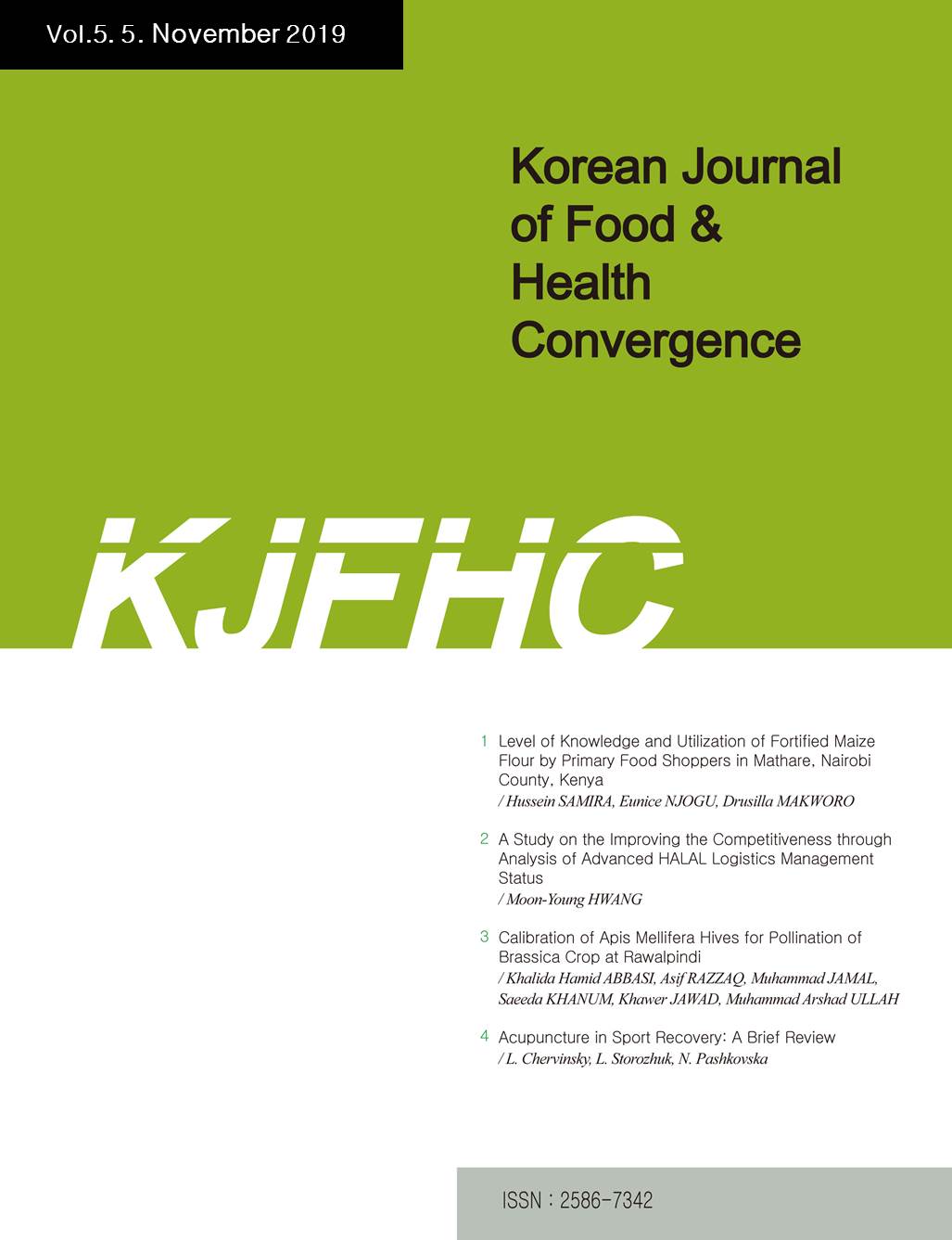 E-ISSN : 2586-7342
E-ISSN : 2586-7342
Vol.9 No.4
Abstract
This study examined the quality characteristics to evaluate the optimal mixing ratio of a chlorella powder in Cheongpomuk. The total polyphenol and total flavonoids contents of Cheongpomuk and chlorella powder was 279.90 ㎍/mL, 489.50 ㎍/mL and 48.79 ㎍/mL, 687.85 ㎍/mL respectively. The DPPH free radical scavenging activities and ABTS radical scavenging activities of chlorella powder was 65.39%, 91.28% respectively. The L values (58.85~26.23), a values (-0.44~-5.84) of the Hunter's color values decreased and b value (-10.98 ~4.12) increased significantly in proportion to the amount of chlorella powder. The total polyphenol contents (55.00~734.20 ㎍/mL), total flavonoids contents (41.00~88.29 ㎍/mL), DPPH free radical scavenging activities (35.10~65.50%) and ABTS radical scavenging activities (50.29~92.86%) of Cheongpomuk increased significantly in groups of chlorella powder. In the physical properties, the hardness (135.93~103.93 g/㎠), chewiness (6.76~3.76 g), springiness (4.92~4.36 %), and gumminess (147.70~94.23) of Cheongpomuk decreased significantly in proportion to the amount of chlorella powder. The Cheongpomuk containing 15% chlorella powder showed a high score with regard to color, flavor, moistness, chewiness and overall acceptance. The appropriate addition amount of chlorella powder for making Cheongpomuk is 15%. This study indicate that Cheongpomuk treated with chlorella powder had the highest functional component and antioxidant activity.
Abstract
Oil was extracted from cashew nuts. The physicochemical parameters of the oil were determined. A chromatographic assay of the oil was carried out using Gas Chromatography-Mass Spectrometry. Seventeen compounds were detected: Phenol, Phenol 2-methyl-, Cyclohexene 4, 4-dimethyl-, m-Fluoro-2-diazoacetophenone 4-dimethyl-, Tetradecanoic acid, Phenol 4-octyl-, n-Hexadecanoic acid. Others are 9, 12-Octadecadienoic acid (Z, Z) - methyl ester, Hexadecanoic acid methyl ester, Methyl stearate, Dodecanoic acid methyl ester, 9, 12, 15-Octadecatrienoic acid methyl ester, 9, 12, 15-Octadecatrienoic acid (Z, Z, Z)-, Oleic acid, Octadecanoic acid, Tetracosanoic acid and 9-Octadecenoic acid methyl ester. Among the components are omega three and omega six essential free fatty acids. The rheological profiling and flow properties of cashew nut oil were determined using a Programmable Rheometer. Cashew nut oil exhibits slight dilatant behaviour at the low end of shear rate. The long chain and high molecular weight of its constituents controlled its rheology. Long-chained 9-Octadecenoic acid methyl ester, 9, 12-Octadecadienoic acid (Z, Z) - methyl ester, Tetracosanoic acid and methyl stearate, coupled with their high molecular weights are responsible for the shear thickening effect observed. Two models, Carreau-Yasuda and Ostwald-de Waele Power Law were employed to fit the rheological data. The Carreau-Yasuda model followed well the data.
Abstract
The integration of ChatGPT, an AI-powered language model, is causing a profound transformation within the food industry, impacting various domains. It offers novel capabilities in recipe creation, personalized dining, menu development, food safety, customer service, and culinary education. ChatGPT's vast culinary dataset analysis aids chefs in pushing flavor boundaries through innovative ingredient combinations. Its personalization potential caters to dietary preferences and cultural nuances, democratizing culinary knowledge. It functions as a virtual mentor, empowering enthusiasts to experiment creatively. For personalized dining, ChatGPT's language understanding enables customer interaction, dish recommendations based on preferences. In menu development, data-driven insights identify culinary trends, guiding chefs in crafting menus aligned with evolving tastes. It suggests inventive ingredient pairings, fostering innovation and inclusivity. AI-driven data analysis contributes to quality control, ensuring consistent taste and texture. Food writing and marketing benefit from ChatGPT's content generation, adapting to diverse strategies and consumer preferences. AI-powered chatbots revolutionize customer service, improving ordering experiences, and post-purchase engagement. In culinary education, ChatGPT acts as a virtual mentor, guiding learners through techniques and history. In food safety, data analysis prevents contamination and ensures compliance. Overall, ChatGPT reshapes the industry by uniting AI's analytics with culinary expertise, enhancing innovation, inclusivity, and efficiency in gastronomy.
